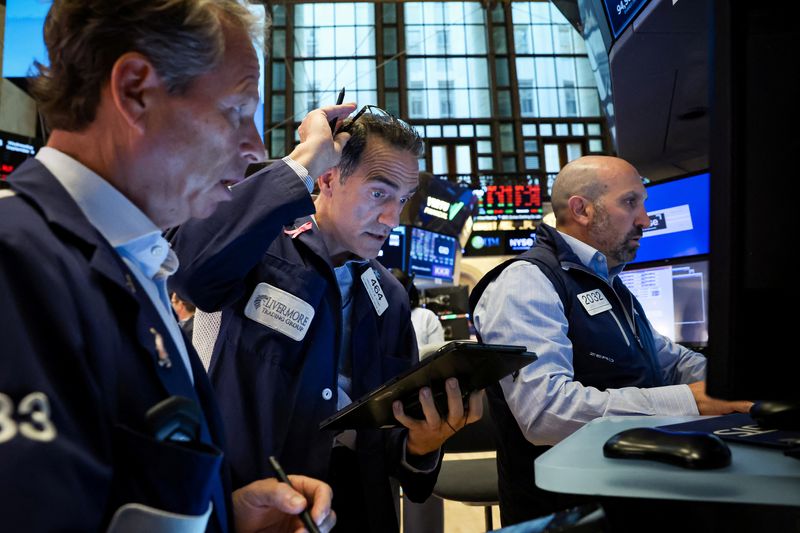A look at the day ahead in U.S. and global markets from Mike Dolan
The unexpected downturn in U.S. household confidence this month and growing anxiety about jobs has spurred aggressive interest rate cut bets anew - dragging Treasury yields, the dollar and stock futures lower into Wednesday's open.
Feeding mostly off the employment signals in Tuesday's consumer survey, rate futures now price some 40 basis points off Federal Reserve rates at its next meeting - just days after November's election. That now puts the chances of a half point cut rather than a quarter point move at more than 50%.
After a decent auction of new paper late yesterday, two-year Treasury yields are within a whisker of 3.5% for the first time in two years. A 'bull steepening' of the 2-10 year yield curve - which sees two-year yields drop more than falling 10-year yields - pushed the newly positive gap above 20bp for the first time since June 2022.
The constellation sapped the dollar index, which is now a hair's breadth from its low for the year, and the surprising disturbance in the growth picture has dragged U.S. stock futures off record highs ahead of Wednesday's bell.
The cat among the pigeons came from the Conference Board's latest consumer survey, which revealed the biggest drop in confidence in three years in September amid mounting fears over the labor market.
The share of households viewing jobs as "plentiful" dropped to the lowest since March 2021. The survey's so-called labor market differential, derived from data on respondents' views on whether jobs are plentiful or hard to get, fell to 12.6 - the narrowest in 3-1/2 years.
And the rush to loosen interest rates gathered momentum around the world, with China following Tuesday's monetary easing blitz of mortgage rate cuts and stock buying incentives with a hefty 30bps cut to its medium-term loan rate.
Chinese stocks and the yuan added to Tuesday's surge, the latter hitting another 16-month high, on fresh hopes the authorities may finally be prepared to go big in stimulating the wavering economy.
While Beijing's latest moves are getting the benefit of the doubt so far, most overseas investors feel the credit easing will only have a chance of turning around the demand picture and property bust if combined with more serious fiscal action on the housing situation. A necessary but not yet sufficient move, in the parlance of economics wonks.
While the yuan's rise on the deep rate cuts seems odd, it appears to be riffing more off growth hopes and stock market stimulus. Chinese government bond yields ticked higher too.
The property market isn't China's only concern, however.
Beijing on Wednesday urged the United States to stop "unreasonable suppression" of its companies, in response to U.S. proposals to ban Chinese software and hardware in vehicles on its roads due to national security concerns.
Few places would welcome a recovery of Chinese demand more than Europe, where this week's September business surveys from Germany and across the bloc revealed an alarming relapse in business and manufacturing into contractionary territory.
So much so that money market bets put the chances of a third European Central Bank rate cut of the year as soon as next month above 50% for the first time. With the euro flirting with the year's high of $1.12 against a waning dollar, there's increasing room to cut again.
What's more, an ECB study Wednesday said wage pressures are easing across the euro zone, driven in great part by lower additional compensation paid on top of negotiated wages and likely contributing to a further moderation of inflation.
Sweden's central bank is not hanging about, and the Riksbank cut its key policy rate on Wednesday by another quarter point to 3.25% - its third of the year - adding that if the inflation outlook remained favourable it could ease policy at a faster pace in the months ahead.
Despite the Reserve Bank of Australia holding the line this week, news that Australian headline inflation fell back into the central bank's target zone last month will have been encouraging there too.
The Swiss National Bank, meantime, is set to cut again on Thursday.
The latest soundings from Bank of England hawk Megan Greene, on the other hand, continued to suggest the BoE would not rush into further sharp easing. And sterling continues to climb.
Elsewhere, the latest U.S. election polling continues to indicate a tight race, although the most recent Reuters/IPSOS rolling survey did indicate a widening gap in favor Democrat Kamala Harris - with some 47% support as against 40% for rival Donald Trump.
In company news in Europe, SAP shares declined 3.6% after a report said the German software developer was under investigation in the United States for alleged price-fixing.
Key developments that should provide more direction to U.S. markets later on Wednesday:
* U.S. August new home sales
* Federal Reserve Board Governor Adriana Kugler speaks
* US corporate earnings: Costco (NASDAQ:COST), Micron Technology (NASDAQ:MU)
* US Treasury sells $70 billion of 5-year notes, auctions 2-year floating rate notes

* United Nations General Assembly in New York
(This story has been corrected to say there is more than a 50% chance of a half point cut, not 80%, in paragraph 2)
(By Mike Dolan; Editing by Toby Chopra; mike.dolan@thomsonreuters.com)